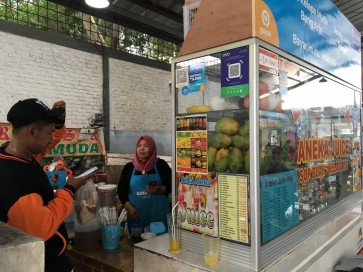Popular Reads
Top Results
Can't find what you're looking for?
View all search resultsPopular Reads
Top Results
Can't find what you're looking for?
View all search results‘No more coins’: Micromerchants embrace cashless payments with direct assistance
The number of cashless transactions in Indonesia rose to over 2 billion in 2018, accounting for around 20 percent of the total 10 billion transactions in Southeast Asia.
Change text size
Gift Premium Articles
to Anyone
O
nly a year ago, Widiastuti, 35, a food seller in an office canteen located in South Jakarta, knew nothing about Quick Response (QR) Code technology for payments. Back then, cash was still king in her food stall business, which sells nasi rames (steamed rice served with various dishes).
Today, around 60 percent of her food stall’s transactions are made through GoPay’s QR code payment system, which she started using just eight months ago. Her customers, she said, warmly welcomed the innovation as they could simply scan a barcode with their mobile phone to pay for meals.
For Widiastuti, handling payments has become more efficient.
“I don’t need to provide smaller banknotes or coins anymore for change,” she told The Jakarta Post.
However, things were not easy for her and other food sellers at the canteen when the GoPay team approached them to introduce the cashless payment method.
Read also: Female internet users contribute to rapid adoption of e-money in Indonesia
“But as time went by, we became used to it. And the [GoPay] team helped us adjust to the new system by standing by at the canteen,” she said. “Now, we can contact them anytime a problem occurs. So, we feel there is a kinship [between the food sellers and GoPay].”


















